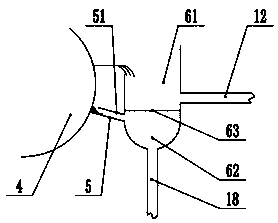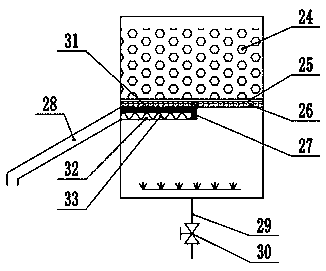Microbial sewage treatment system and sewage treatment method
A sewage treatment system and microorganism technology, applied in biological water/sewage treatment, biological treatment device, water/sludge/sewage treatment, etc., can solve problems such as the removal of unfavorable nitrogen and phosphorus pollutants, and achieve the goal of improving water quality and reducing costs. Effect
- Summary
- Abstract
- Description
- Claims
- Application Information
AI Technical Summary
Problems solved by technology
Method used
Image
Examples
Embodiment 1
[0031] attached figure 1 It is a schematic diagram of the structure of this embodiment. The microbial sewage treatment system includes a microbial combination pool, a sludge collection system, a sludge transportation system, a recovery system, an aeration system, etc., wherein the microbial combination pool includes an aerobic pool 1, an anoxic pool 2 and Anaerobic pool 3, during sewage treatment, sewage flows in successively.
[0032] The sludge collection system is located in the anaerobic tank 3 and includes a magnetic drum 4 , a scraper 5 and a collector 6 . The specific structure is attached figure 2As shown, the collector 6 is located in the anaerobic tank 3 at the rear end of the microbial combination tank, and can be an integrated structure separated up and down by a partition 63, the upper part is an overflow tank 61, and the lower part is a mud receiving tank 62. The overflow tank 61 and the mud receiving tank 62 can also be made separately and assembled into the ...
Embodiment 2
[0050] attached Figure 4 It is a schematic plan view of the existing domestic sewage treatment facilities. The sewage treatment capacity is 10,000 tons per day. The process is "selection pool + oxidation ditch". Sewage first enters the selection pool 101, then enters the oxidation ditch 102, flows through the aerobic zone 104, the anoxic zone 105, and the anaerobic zone 106 in turn, and finally flows out through the water collection weir 103. In the aerobic zone 104, an aeration device II 17 connected with the fan 11 is provided. Under the action of microorganisms, organic matter degradation, nitrification, and aerobic phosphorus uptake will occur in the sewage. In the anoxic zone 105, denitrification and denitrification will occur. Anaerobic phosphorus release occurs.
[0051] Table 1 Water quality comparison table
[0052] name COD mg / L Ammonia nitrogen mg / L Total nitrogen mg / L Total phosphorus mg / L flooded 320 46 53 6 Raw water 48 5 16 ...
Embodiment 3
[0067] attached Figure 6 It is a schematic diagram of the structure of this example. Compared with Example 1, the obvious difference is: 1) The order of the functional pools of the microbial combination pool is different, and the sewage flows through the anaerobic pool 3, the anoxic pool 2, and the aerobic pool 1; 2 ) The overflow tank 61 is separated from the sludge collection tank 62 and placed in the anaerobic pool 3 at the front end of the microbial combination pool; 3) The mud collection tank 62 and the sludge collection system are placed in the aerobic pool 1 at the rear end of the biological combination pool, and The upper mouth of the mud collection tank 62 is higher than the water surface to ensure that the return pump 15 transports the magnetically active sludge; 4) The magnetically active sludge and the supernatant from the dephosphorization treatment are both transported back to the anaerobic pool 3 at the front end of the microbial combination pool Middle; 5) The...
PUM
| Property | Measurement | Unit |
|---|---|---|
| particle diameter | aaaaa | aaaaa |
| thickness | aaaaa | aaaaa |
Abstract
Description
Claims
Application Information
 Login to View More
Login to View More - R&D
- Intellectual Property
- Life Sciences
- Materials
- Tech Scout
- Unparalleled Data Quality
- Higher Quality Content
- 60% Fewer Hallucinations
Browse by: Latest US Patents, China's latest patents, Technical Efficacy Thesaurus, Application Domain, Technology Topic, Popular Technical Reports.
© 2025 PatSnap. All rights reserved.Legal|Privacy policy|Modern Slavery Act Transparency Statement|Sitemap|About US| Contact US: help@patsnap.com



